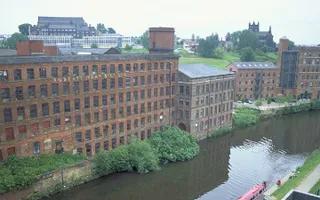The internationally recognised definition of heritage is broadly a social consideration as defined by the International Cultural Tourism Charter and recognised by Historic England, but it is appreciated that heritage is also linked to the wellbeing of the environment.
In England and Wales it's our responsibility to look after:
- 2,000 miles of historic waterways
- 46 scheduled monuments
- 2,706 listed buildings
- 304 conservation areas
Our waterways are also touched by other heritage designations, including four World Heritage Sites, 42 historic parks and gardens and six historic battlefields.
Planning policies need to protect and enhance waterway heritage and landscape character.
Example 1 - the super slow way project
We are involved in a major Arts Council England funded commissioning programme in Pennine Lancashire, the super slow way project. Together with private and public partners, we're working with communities along the Leeds & Liverpool Canal to explore how they relate to their environment, neighbourhoods and each other. The long term aim is to create the UK's first linear industrial heritage landscape park and new visitor destination.
Example 2 - Black Country Core Strategy (adopted 2011)
Policy ENV4 on canals shows the multi-functional nature of the waterways including reference to their special historic, architectural, archaeological and cultural interest.
"The Black Country canal network comprises the canals and their surrounding landscape corridors, designated and undesignated historic assets, character, settings, views and interrelationships. The canal network can provide a focus for future development through the potential to provide a high quality environment and accessibility. All development proposals likely to affect the canal network must:
- safeguard the operation of a navigable and functional waterway
- protect and enhance its special historic, architectural, archaeological and cultural interest (including potential to record, preserve and restore such features)
- protect and enhance its nature conservation value
- protect and enhance its visual amenity
- protect and enhance water quality in the canal
Where opportunities exist, all development proposals within the canal network must:
- enhance and promote its leisure, recreation and tourism value
- improve and promote walking, cycling and boating access, including for freight
- promote beneficial and multifunctional use of the canal network
Such development proposals must be fully supported by evidence that the above factors have been fully considered and properly incorporated into their design and layout. Where proposed development overlays part of the extensive network of disused canal features, the potential to record, preserve and restore such features must be fully explored. Development will not be permitted which would sever the route of a disused canal or prevent the restoration of a canal link where there is a realistic possibility of restoration, wholly or in part."




